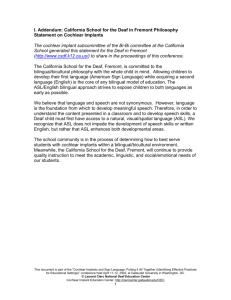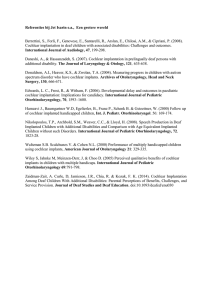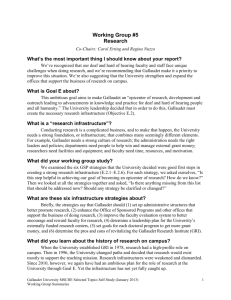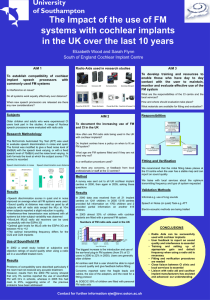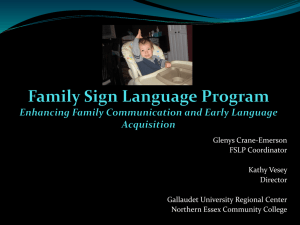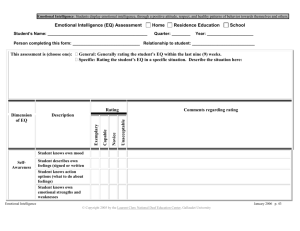Text of presentation - Gallaudet University
advertisement
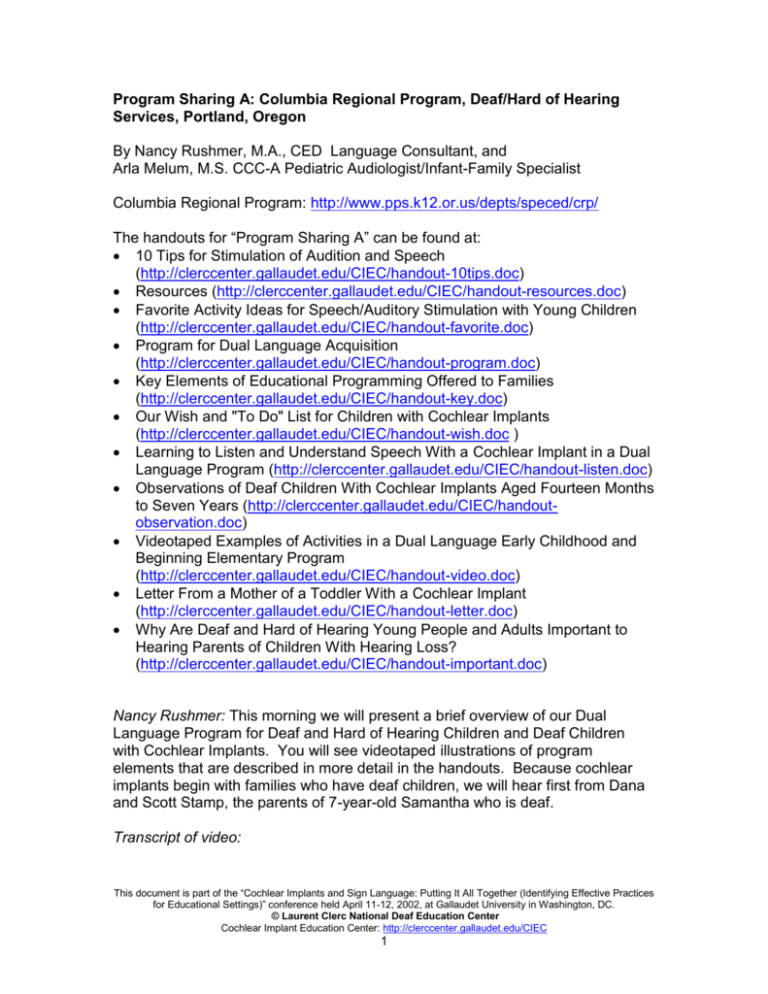
Program Sharing A: Columbia Regional Program, Deaf/Hard of Hearing Services, Portland, Oregon By Nancy Rushmer, M.A., CED Language Consultant, and Arla Melum, M.S. CCC-A Pediatric Audiologist/Infant-Family Specialist Columbia Regional Program: http://www.pps.k12.or.us/depts/speced/crp/ The handouts for “Program Sharing A” can be found at: 10 Tips for Stimulation of Audition and Speech (http://clerccenter.gallaudet.edu/CIEC/handout-10tips.doc) Resources (http://clerccenter.gallaudet.edu/CIEC/handout-resources.doc) Favorite Activity Ideas for Speech/Auditory Stimulation with Young Children (http://clerccenter.gallaudet.edu/CIEC/handout-favorite.doc) Program for Dual Language Acquisition (http://clerccenter.gallaudet.edu/CIEC/handout-program.doc) Key Elements of Educational Programming Offered to Families (http://clerccenter.gallaudet.edu/CIEC/handout-key.doc) Our Wish and "To Do" List for Children with Cochlear Implants (http://clerccenter.gallaudet.edu/CIEC/handout-wish.doc ) Learning to Listen and Understand Speech With a Cochlear Implant in a Dual Language Program (http://clerccenter.gallaudet.edu/CIEC/handout-listen.doc) Observations of Deaf Children With Cochlear Implants Aged Fourteen Months to Seven Years (http://clerccenter.gallaudet.edu/CIEC/handoutobservation.doc) Videotaped Examples of Activities in a Dual Language Early Childhood and Beginning Elementary Program (http://clerccenter.gallaudet.edu/CIEC/handout-video.doc) Letter From a Mother of a Toddler With a Cochlear Implant (http://clerccenter.gallaudet.edu/CIEC/handout-letter.doc) Why Are Deaf and Hard of Hearing Young People and Adults Important to Hearing Parents of Children With Hearing Loss? (http://clerccenter.gallaudet.edu/CIEC/handout-important.doc) Nancy Rushmer: This morning we will present a brief overview of our Dual Language Program for Deaf and Hard of Hearing Children and Deaf Children with Cochlear Implants. You will see videotaped illustrations of program elements that are described in more detail in the handouts. Because cochlear implants begin with families who have deaf children, we will hear first from Dana and Scott Stamp, the parents of 7-year-old Samantha who is deaf. Transcript of video: This document is part of the “Cochlear Implants and Sign Language: Putting It All Together (Identifying Effective Practices for Educational Settings)” conference held April 11-12, 2002, at Gallaudet University in Washington, DC. © Laurent Clerc National Deaf Education Center Cochlear Implant Education Center: http://clerccenter.gallaudet.edu/CIEC 1 Mother of Samantha: Do we think that she will develop more rapidly in her oral skills if we drop the sign language? That's not an option. In our eyes, that’s not an option. That is her first language and will always be her first language. She's most comfortable with that, and we're fine with that as a family. And I think maybe she's an oddity, because cochlear implants work differently for different people. She happens to have responded very well. It's been a very smooth transition, for the most part, for her. She's gotten a lot of speech abilities that some other children really don't get, but she doesn't always have it on. She takes a bath. She plays soccer. She goes swimming. She plays in the grass and in the sandbox, things that she can't always have it on for or if the battery dies or whatever. Why should that be okay to let her be without language? Father of Samantha: Everyone knows she has a bold spirit. She just grasped English and is learning it. Mother: It's kind of a New Year's resolution—we've had to add a sign-only day to our life because she is so oral now. At least for me, it really came rapidly. Father: It's like, well, how do we introduce the language? Who takes the lead? In our family, Samantha takes the lead. Sam has that personality where she kind of wants the world to revolve around her. So she will come up to us and she'll say, “Daddy, voice only.” She won't even have her implant on and will tell me that. Or she’ll tell me, “Why should I wear this?” And I say, “I have to sign, you don't have your implant on. How can I voice only? You can't hear.” She'll go, “Oh, I was just joking.” Then, there's times she has her implant on and says, “Voice only,” and I'll only voice or she'll say, “Sign only. There's a lot of noise around. I can't hear. I don't understand.” I think one thing I'm adamant about is, don't take away a method of communication just because you want to improve another. Samantha: [Reading book] “Green Eggs and Ham. I am Sam. I am Sam. Sam I am. That Sam I am. That Sam I am. I do not like that. Sam I am. Do you like green eggs and ham? I do not like them. Sam I am.” [End of video transcript.] Rushmer: Sam is the oldest of the 10 children, ages 7 and younger, we work with who have implants. She was implanted at 33 months, has age-appropriate language, reads above grade level and is actually not so unusual from our perspective. The younger children implanted between 13 and 19 months with newer devices are showing quite rapid acquisition of audition and speech, particularly the 12-month-old we're working with. Our presentation will touch on some aspects of programming for these children. Check your handouts for details and the program’s underpinnings in terms of the philosophy and basic elements. This document is part of the “Cochlear Implants and Sign Language: Putting It All Together (Identifying Effective Practices for Educational Settings)” conference held April 11-12, 2002, at Gallaudet University in Washington, DC. © Laurent Clerc National Deaf Education Center Cochlear Implant Education Center: http://clerccenter.gallaudet.edu/CIEC 2 We began calling our program a dual language program a few years ago to describe the two languages used: American Sign Language (ASL) and English through sign-supported speech, speech, and written English. In Portland, we have strong private and public oral programs for children with cochlear implants. There is also a need for a program for parents like Sam's who want their children to learn both languages. The 10 children we're following display language and speech skills on a continuum from beginning sound awareness and babbling to some with age-level and above auditory comprehension of language and intelligible speech. We have two children, both implanted for two years, one at a beginning babbling stage, the other with oral language understanding one year above her chronological age of 3 ½ years. The rate and growth and level of these skills seem to be related to the factors listed in our handout on page six. Next, we want to show you Myah. She is 3 ½ years old and is one of the kids with above age-level sign and oral language. Her congenital profound deafness was identified at age 1, and she was implanted at 19 months. Myah was in our program for two years and is still in our study. We continue to follow the children if they move away. We also followed kids to the oral-only program to see how they continued their development. For the last six months, Myah has attended Children's Village in Syracuse, New York, where each week she has three to four 45-minute oral language sessions, a weekly home visit for parent sign language, and a weekly home visit from an auditory-verbal therapist. (Video of therapy session was shown; transcript not sufficient to convey the information portrayed in the video. This information is provided for the reader to know the types of videos used in the presentation and the comments of the speakers related to the video.) Rushmer: Next, I want to show you video clips from an adult-led preschool activity to give you an idea of the different ways language is used in this dual language program. We note that at least half of the preschool day is developmental activities chosen by the children. Adults join the children in the different topic areas for informal conversation to support their play and to facilitate development in all areas including language. The first video clip shows dramatic play, the class taking an airplane trip to Hawaii. The last segment is an ASL story. (For the voice interpreter) This is the Napping House story where people and animals pile on top of each other to take a nap. (Video of classroom activity was shown; transcript not sufficient to convey the information portrayed in the video. This information is provided for the reader to know the types of videos used in the presentation and the comments of the speakers related to the video.) This document is part of the “Cochlear Implants and Sign Language: Putting It All Together (Identifying Effective Practices for Educational Settings)” conference held April 11-12, 2002, at Gallaudet University in Washington, DC. © Laurent Clerc National Deaf Education Center Cochlear Implant Education Center: http://clerccenter.gallaudet.edu/CIEC 3 Rushmer: I will conclude my portion of our presentation with a couple of key observations from the list in your handouts. We are seeing some trends in the ways children and families respond to cochlear implants. The first is a contrast with hard of hearing children. Hard of hearing children in the dual language model seem to acquire ASL and speech with less focused individualized auditory programming than do deaf children with cochlear implants, at least in the beginning years. What we have seen with the hard of hearing children in this model is that you couldn't suppress their developing speech, it happens so naturally. This does not seem to be the case with implanted children, at least with those implanted at age 17 months and later. They need to be alerted to attend to sound and to figure out its meaning through an individualized, focused, sequential auditory learning program. A final observation is that it is important to ensure that those deaf children who learn visually and whose primary language is ASL, have sufficient access to an ASL model and sufficient communication partners to acquire the language. At the same time, children with implants need significant linguistic experience with oral communication alone. We have noted that some children with implants turn out to be ASL users who are visual learners, so this is complicated. Arla Melum: I. My role in the Columbia Regional Program is as an educational audiologist and speech consultant providing direct service to children ages 2 to 7 with a variety of hearing losses and amplification systems and functioning at different developmental levels. II. Since I see one of my primary roles as a consultant to classroom teachers, I wanted to share a little about my philosophy as a consultant and why I think our team works so well together: (As you can see, we have a lot of fun together, which is important). I've heard teachers complain in the past about consultants who come in with the attitude that they are the experts in a particular area, and they will educate the teachers about what they think they need to know. This attitude may meet with anger, defensiveness, refusal to cooperate, and/or a general disdain for that professional. My feeling is that the classrooms do not belong to me, and I don't have primary responsibility for them. I want the teachers to be glad to see me! I want them to feel that I have information and knowledge that they may not have that I can share with them. Also, I believe that they have a wealth of information they can share with me. I have the utmost respect for teachers, and I really try to fit into their agenda. I'm always respectful about what they have planned and try to fit what I want to do into their plans for the day. The collaborative model only works if there is mutual respect among professionals based on trust, sharing, compromises and, sometimes, “agreeing to disagree”. This document is part of the “Cochlear Implants and Sign Language: Putting It All Together (Identifying Effective Practices for Educational Settings)” conference held April 11-12, 2002, at Gallaudet University in Washington, DC. © Laurent Clerc National Deaf Education Center Cochlear Implant Education Center: http://clerccenter.gallaudet.edu/CIEC 4 III. I stimulate speech and auditory skills in several ways: A. In the classroom setting, one-on-one with the child and parent present. This first videotaped segment shows Jeremiah and his mother working on supra-segmental features in the classroom. (Videotaped example was shown; transcriptions were not sufficient to convey information present in the videos.) B. I work with children during the morning preschool session. The most critical scenario is to take advantage of situations as they occur during both child and teacher-directed activities, stimulating, modeling, responding and reinforcing the child’s communication. These next segments demonstrate this. (Videotaped example shown.) C. Another way of stimulating the child is individually during preschool time in my tiny speech room or in an empty classroom as it is available. I find this time beneficial, as the environment is quieter and less distracting. This is ideal for performing assessments and working on specific skill areas where focus may be greater. (Videotaped example shown.) D. I work with children during family program time with enrolled children and siblings and friends present. E. I may see children during home visits as my schedule allows. Typically, these visits are shared among staff members with activity ideas tossed around prior to each visit. F. Lastly, at the elementary school level, I utilize the classroom teacher's activities to reinforce and support the auditory, linguistic, speech and literary elements of the child’s individual program. IV. I would like to present our caveat for working with children with hearing loss, whether or not they have a cochlear implant. Our belief is that communication occurs constantly throughout the day. The trick is to recognize these opportunities and be familiar enough with the child's levels to model skills at and slightly above where they are functioning, using activities that are fun and developmentally appropriate. The classroom teachers, consultants, and family members work together as a team to assess the child, develop goals and objectives and determine when these goals are met. V. As you know, assessment is one of the critical first steps in working with any child: This document is part of the “Cochlear Implants and Sign Language: Putting It All Together (Identifying Effective Practices for Educational Settings)” conference held April 11-12, 2002, at Gallaudet University in Washington, DC. © Laurent Clerc National Deaf Education Center Cochlear Implant Education Center: http://clerccenter.gallaudet.edu/CIEC 5 A. The assessments we use are listed in the handout packet that was distributed. B. We found that the most critical data is gathered throughout the child's day. We take lots of data during sessions, often talking with other staff members about what we observe as it happens. For example, I may have targeted the auditory skill for Sophia on the Spice Curriculum: “Can discriminate among a trochee vs. a spondee vs. a 3-syllable word.” The teacher is engaging in play with the child with a dollhouse, furniture, and pretend food. The teacher notes that during this play, Sophia can identify the word “baby” from “bathtub” from “hamburger” through audition alone. The teacher lets me know so I can write it down right away. We may note a child’s vocalizations, use of speech at the word, phrase or sentence level, what the child understands through listening only and/or with varying amounts of information such as speech reading cues, use and understanding of ASL, awareness of environmental sounds and so on. C. This information is also shared later during individual and team meetings with the teachers in order to adjust our goals and objectives for the child. VI. Now, I would like to briefly discuss techniques for providing auditory/oral stimulation with this population. I have developed my top 10 list, a la David Letterman. This list is also included in your packet (http://clerccenter.gallaudet.edu/CIEC/handout-10tips.doc). It is definitely not the “be all, end all.” 1. Provide fun, developmentally appropriate activities to stimulate the child. 2. Keep speech and audition goals in your mind while involved in play with the child. (I try to change the goals every few weeks and post them for the teacher's easy reference). 3. Reinforce the child's current skills and model skills at a level slightly above where the child is functioning. 4. Present information through listening whenever possible to stimulate the auditory mode. 5. Provide sufficient time for the child to process what he has heard before adding a speech reading cue and/or sign. (Challenge the child a little bit). This document is part of the “Cochlear Implants and Sign Language: Putting It All Together (Identifying Effective Practices for Educational Settings)” conference held April 11-12, 2002, at Gallaudet University in Washington, DC. © Laurent Clerc National Deaf Education Center Cochlear Implant Education Center: http://clerccenter.gallaudet.edu/CIEC 6 6. When promoting speech and audition skills for children who also use sign language, add signs as needed when new concepts are introduced or for clarification. Here the teacher changes her mode of communication to fit different children’s needs. (Videotaped example shown.) 7. Encourage the child to imitate the speech he has heard, accepting approximations when developing a new skill. 8. Provide frequent opportunities to hear new linguistic information. This next segment shows a newly implanted child, with the teacher modeling sign language and vocal sounds. (Videotaped example shown.) 9. Give the child an opportunity to be the "teacher" to practice the skills. In the next segment, you see Hope and Sophia taking turns being the “listener” and “teacher.” (Videotaped example shown.) 10. Take advantage of opportunities to stimulate speech and audition throughout the child's day. VII. I would like to end with a quote from Jeremiah’s mother, which I think puts all this nicely into the proper perspective: “I think it is so important to the deaf child that his parents accept him just as he is. My concern about cochlear implants now is that some parents of newly identified deaf infants are immediately advised to get the implant as soon as they can. I think kids can sense when they are totally accepted. When the implant is off, Jeremiah is still deaf. We don’t put a tremendous amount of pressure on Jeremiah. I think that a 2-year-old can sense that. We accept him as he is and he has the freedom to develop at his own pace. Early on there wasn’t an expectation that Jeremiah would be able to hear and talk so now, with every new listening and speaking skill he acquires, we are just thrilled! Finally, one of the most important gifts we can give Jeremiah is the sense that he is accepted for just who he is. Because we are willing to speak his natural language, we feel that this is the missing link for him.” Thank you very much! This document is part of the “Cochlear Implants and Sign Language: Putting It All Together (Identifying Effective Practices for Educational Settings)” conference held April 11-12, 2002, at Gallaudet University in Washington, DC. © Laurent Clerc National Deaf Education Center Cochlear Implant Education Center: http://clerccenter.gallaudet.edu/CIEC 7

